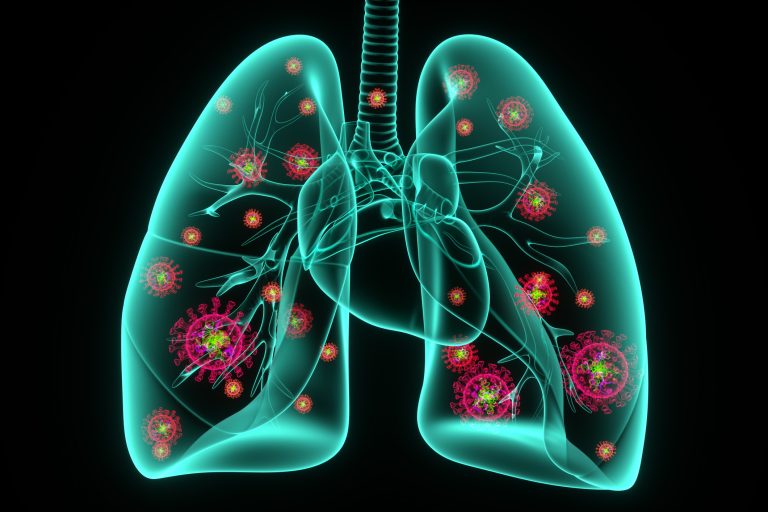
If you think breathing in gene editing enzymes to treat infectious diseases, such as the flu or COVID-19, is a technology that is far-fetched or a long way off, think again. A team of investigators from the Georgia Institute of Technology and Emory University has developed a CRISPR-based treatment to stop the replication of both the flu virus and the virus that causes COVID-19 in mice. Moreover, the new treatment is delivered to the lungs via a nebulizer, which could make it simple for patients to administer themselves at home. Findings from the new study were published recently in Nature Biotechnology through an article titled, “Treatment of influenza and SARS-CoV-2 infections via mRNA-encoded Cas13a in rodents.”
Interestingly, the researchers used mRNA technology to code for Cas13a, which destroys parts of the RNA genetic code that viruses use to replicate in cells in the lungs. Using a guide strand, researchers can provide a map that basically tells the Cas13a protein where to attach to the viruses’ RNA and begin to destroy it.
“In our drug, the only thing you have to change to go from one virus to another is the guide strand—we only have to change one sequence of RNA. That’s it,” explained senior study investigator Phillip Santangelo, PhD, a professor in the Wallace H. Coulter department of biomedical engineering at Emory University. “We went from flu to SARS-CoV-2, the virus that causes COVID-19. They’re incredibly different viruses. And we were able to do that very, very rapidly by just changing a guide.”
Santangelo’s team tested its approach against flu in mice and SARS-CoV-2 in hamsters. In both cases, the sick animals recovered. This is the first study to show mRNA can be used to express the Cas13a protein and get it to work directly in lung tissue rather than in cells in a dish. It’s also the first to demonstrate the Cas13a protein is effective at stopping the replication of SARS-CoV-2.
Amazingly, the team’s approach has the potential to work against 99% of flu strains that have circulated over the last century. It also appears it would be effective against the new highly contagious variants of the coronavirus that have begun to circulate. The key to that broad effectiveness is the sequence of genes the researcher’s target.
“In flu, we’re attacking the polymerase genes. Those are the enzymes that allow the virus to make more RNA and to replicate,” Santangelo noted. “We went after those because they’re far better conserved. We let the biology dictate what our targets would be.”
Likewise, in SARS-CoV-2, the sequences the researchers targeted so far remain unchanged in the latest variants. The approach means the treatment is flexible and adaptable as new viruses emerge.
“One of the first things that society and the CDC are going to get when a pandemic emerges is the genetic sequence. It’s one of the first tools that the CDC and the surveillance teams are going to use to identify what kind of virus this is and to begin tracking it,” remarked study co-author Daryll Vanover, PhD, a research scientist in the Santangelo lab. “Once the CDC publishes those sequences—that’s all we need. We can immediately screen across the regions that we’re interested in to target it and knock down the virus.”
Vanover noted that this could result in lead candidates for clinical trials in a matter of weeks—which is about how long it took them to scan the sequences, design their guide strands, and be ready for testing in this study.
“It’s really quite plug-and-play,” Santangelo added. “If you’re talking about small tweaks versus large tweaks, it’s a big bonus in terms of time. And in pandemics—if we had had a vaccine in a month or two after the pandemic hit, think about what things would look like now. If we had a therapy a month after it hit, what would things look like now? It could make a huge difference, the impact on the economy, the impact on people.”
The team’s approach was sped along by their previous work on delivering mRNA to mucosal surfaces like those in the lungs. They knew there was a good chance they could tackle respiratory infections with that approach. They decided to use mRNA to code for the Cas13a protein because it’s an inherently safe technique.
“The mRNA is transient. It doesn’t get into the nucleus, doesn’t affect your DNA,” Santangelo said, “and for these CRISPR proteins, you really don’t want them expressed for long periods of time.”
The researchers were excited about their findings but said that additional work remains—especially understanding more about the specific mechanisms that make the treatment effective. It has produced no side effects in the animal models, but they want to take a deeper look at safety as they consider moving closer to therapy for human patients.
“This project really gave us the opportunity to push our limits in the lab in terms of techniques, in terms of a new strategy,” concluded Chiara Zurla, PhD, the team’s project manager and a co-author on the paper. “Especially with the pandemic, we feel an obligation to do as much as we can as well as we can. This first paper is a great example, but many will follow; we’ve done a lot of work, and we have a lot of promising results.”












